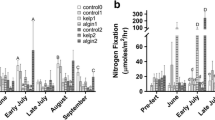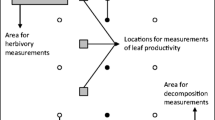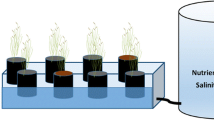Abstract
We report the first data on belowground tissue mass and nitrogen (N) concentration forSpartina foliosa in southern California, assessing one natural and two constructed marshes on San Diego Bay. Biomass at the natural marsh was low compared to that of otherSpartina spp., but higher than values reported forS. foliosa in northern California. In sandy constructed marshes planted 5 and 10 years before this study,S. foliosa had lower belowground tissue N, lower N crop (%N×biomass), and shallower roots than in the adjacent natural marsh. We took advantage of a 2-yr, large-scale fertilization project being performed in the older constructed marsh and examined biomass and N storage after N additions. Although there was a trend toward N accumulation with fertilization, N crop remained at approximately 50% of natural marsh levels, unlike the large aboveground responses to N addition in our previous studies. Lower belowground reserves help to explain poor aerial growth in the created marshes and suggest the need for finer sediments (with greater potential for holding and supplying nutrients) to sustain (S. foliosa. While fine sediments are beginning to accumulate on the surface of the created marshes, vertical accretion is more likely to shift the plant community toward other species than to enhanceS. foliosa growth. We suggest salvaging and importing fine, organic marsh sediments or providing organic amendments to establish proper substrate conditions. Overexcavating and allowing fine sediments to accumulate remains an option, although the time scale is unpredictable due to the stochasticity of accretion events.
Similar content being viewed by others
Literature Cited
Abrahamson, W. G., andH. Caswell. 1982. On the comparative allocation of biomass, energy and nutrients in plants.Ecology 63:982–991.
Anderson, I. C., C. R. Tobias, B. B. Neikirk, andR. L. Wetzel. 1997. Development of a process-based nitrogen mass balance model for a Virginia (USA)Spartina alterniflora salt marsh: Implications for net DIN flux.Marine Ecology Progress Series 159: 13–27.
Bouyoucos, G. J. 1962. Hydrometer method improved for making particles size analyses of soils,Agranomy Journal 54:464–465.
Boyer, K. E., andJ. B. Zedler. 1996. Damage to cordgrass by scale insects in a constructed salt marsh: Effects of nitrogen additions.Estuaries 19:1–12.
Boyer, K. E., andJ. B. Zedler. 1998. Effects of nitrogen additions on the vertical structure of a constructed cordgrass marsh.Ecological Applications 8:692–705.
Boyer, K. E., andJ. B. Zedler. 1999. Nitrogen addition could shift plant community composition in a restored California salt marsh.Restoration Ecology 7:74–85.
Boyer, K. E., J. B. Zedler, S. Phinn, G. D. Williams, G. B. Noe, S. Trnka, and B. Fink. 1996. The Status of Constructed Wetlands at Sweetwater Marsh National Wildlife Refuge. Annual Report to the California Department of Transportation and the U.S. Fish and Wildlife Service, Pacific Estuarine Research Laboratory, San Diego, California.
Broome, S. W., E. D. Seneca, andW. W. Woodhouse. 1986. Long-term growth and development of transplants of the saltmarsh grassSpartina alterniflora.Estuaries 9:63–74.
Cahoon, D. R., J. C. Lynch, andA. N. Powell. 1996. Marsh vertical accretion in a southern California estuary, U.S.A..Estuarine, Coastal and Shelf Science 43:19–32.
Callaway, J. C., andM. N. Josselyn. 1992. The introduction and spread of smooth cordgrass (Spartina alterniflora) in south San Francisco Bay.Estuaries 15:218–226.
Cantilli, J. F. 1989. Sulfide phytotoxicity in tidal salt marshes. Thesis, San Diego State University, San Diego, California.
Capehart, A. A., andC. T. Hackney. 1989. The potential role of roots and rhizomes in structuring salt-marsh benthic communities.Estuaries 12:119–122.
Chapin III,F. S., E. D. Schulze, andH. A. Mooney. 1990. The ecology and economics of storage in plants.Annual Review of Ecology and Systematics 21:423–447.
Craft, C. B., S. W. Broome, andE. D. Seneca. 1988. Nitrogen. phosphorus and organic carbon pools in natural and transplanted marsh soils.Estuaries 11:272–280.
Craft, C. B., J. Reader, J. N. Sacco, andS. W. Broome. 1999. Twenty-five years of ecosystem development of constructedSpartina alterniflora (Loisel) marshes.Ecological Applications 9: 1405–1419.
Dai, T., andR. G. Wiegert. 1996. Ramet population dynamics and net aerial productivity ofSpartina alterniflora.Ecology 77: 276–288.
DeLaune, R. D., andS. R. Pezeshki. 1988. Relationship of mineral nutrients to growth ofSpartina alterniflora in Louisiana salt marshes.Northeast Gulf Science 10:55–60.
Dong, M., andH. de Kroon. 1994. Plasticity in morphology and biomass allocation inCynodon dactylon, a grass species forming stolons and rhizomes.Oikos 70:99–106.
Eberhardt, L. L., andJ. M. Thomas. 1991. Designing environmental field studies.Ecological Monographys 61:53–73.
Gallagher, J. L. 1974. Sampling macro-organic matter profiles in salt marsh plant root zones.Soil Science Society of America Proceedings 38:154–155.
Gallagher, J. L. 1975. Effect of an ammonium nitrate pulse on the growth and elemental composition of natural stands ofSpartina alterniflora andJuncus roemerianus.American Journal of Botany 62:644–648.
Gallagher, J. L., andR. W. Howarth. 1987. Seasonal differences inSpartina recoverable undergrund reserves in the Great Sippewissett Marsh in Massachusetts.Estuarine, Coastal and Shelf Science 25:313–319.
Gallagher, J. L., andF. G. Plumley. 1979. Underground biomass profiles and productivity in Atlantic coastal marshes.American Journal of Botany 66:156–161.
Gee, G. W., andJ. W. Bauder. 1986. Particle-size analysis, p. 383–411.In A. Klute (ed.), Methods of Soil Analysis: Part I: Physical and Mineralogical Methods. American Society of Agronomy, Madison, Wisconsin.
Good, R. E., N. E. Good, andB. R. Frasco. 1982. A review of primary production and component, p. 139–157.In V. S. Kenndy (ed.), Estuarine Comparisons. Academic Press, New York.
Gross, M. F., M. A. Hardisky, P. L. Wolf, andV. Klemas. 1991. Relationship between aboveground and belowground biomass ofSpartina alterniflora (smooth cordgrass).Estuaries 14: 180–191.
Hackney, C. T., andA. A. de la Cruz. 1986. Belowground productivity of roots and rhizomes in a giant cordgrass marsh.Estuaries 9:112–116.
Haltiner, J., J. B. Zedler, K. E. Boyer, G. D. Williams, andJ. C. Callaway. 1997. Influence of physical processes on the design, functioning and evolution of restored tidal wetlands in California (USA).Wetlands Ecology and Management 4:73–91.
Hargis, T. G., andR. R. Twilley. 1994. Improved coring device for measuring soil bulk density in a Louisiana deltaric marsh.Journal of Sedimentary Research Section A: Sedimentary Petrology and Processes 64:681–683.
Hopkinson, C. S., andJ. P. Schubauer. 1984. Static and dynamic aspects of nitrogen cycling in the salt marsh graminoid,Spartina alterniflora Loisel.Ecology 65:961–969.
Hull, R. J., D. M. Sullivan, andR. W. Lytle. 1976. Photosynthate distribution in natural stands of salt water cordgrass.Agronomy Journal 68:969–972.
Klimes, L., J. Klimesova, andJ. Osbornova. 1993. Regeneration capacity and carbohydrate reserves in a clonal plantRumex alpinus: Effect of burial.Vegetatio 109:153–160.
Langis, R., M. Zalejko, andJ. B. Zedler. 1991. Nitrogen assessments in a constructed and a natural salt marsh of San Diego Bay, California.Ecological Applications 1:40–51.
LaSalle, M. W., M. C. Landin, andJ. G. Sims. 1991. Evaluation of the flora and fauna of aSpartina alterniflora marsh established on dredged material in Winyah Bay, South Carolina.Wetlands 11:191–208.
Lindau, C. W., andL. R. Hossner. 1981. Substrate characterization of an experimental marsh and three natural marshes.Soil Science Society of America Proceedings 45:1171–1176.
Livingstone, D. C., andD. G. Patriquin. 1981. Belowground growth ofSpartina alterniflora Loisel: Habit, functional biomass and non-structural carbohydrates.Estuarine, Coastal and Shelf Science 12:579–588.
Louahlia, S., J. H. MacDuff, A. Ourry, M. Humphreys, andJ. Boucaud. 1999. Nitrogen reserve status affects the dynamics of nitrogen remobilization and mineral nitrogen uptake during recovery of contrasting cultivars ofLolium perenne from defoliation.New Phytologist 142:451–462.
Lytle, R. W. andR. J. Hull. 1980. Annual carbohydrate variation in culms and rhizomes of smooths cordgrass (Spartina alterniflora Loisel).Agronomy Journal 72:933–942.
Mahall, B. E., andR. B. Park. 1976. The ecotone betweenSpartina foliosa Trin. andSalicornia virginica L. in salt marshes of northern San Francisco Bay: I. Biomass and production.Journal of Ecology 64:421–433.
Millard, P. 1988. The accumulation and storage of nitrogen by herbaceous plants.Plant, Cell and Environment 11:1–8.
Morris, J. T., andB. Haskin. 1990. A 5-yr record of aerial primary production and stand characteristics ofSpartina alterniflora.Ecology 7:2209–2217.
Osgood, D. T., andJ. C. Zieman. 1993. Factors controlling above-groundSpartina alterniflora (smooth cordgrass) tissue element composition and production in different-age barrier island marshes.Estuaries 16:815–826.
Ourry, A., T. H. Kim, andJ. Boucaud. 1994. Nitrogen reserve mobilization during regrowth ofMedicago sativa L: Relationships between their availability and regrowth yield.Plant Physiology 105:831–837.
Phinn, S. R., D. A. Stow, andJ. B. Zedler. 1996. Monitoring wetland habitat restoration in southern California using airborne multispectral video data.Restoradion Ecology 4:412–422.
Roman, C. T., andF. C. Daiber. 1984. Aboveground and below-ground primary production dynamics of two Delaware Bay tidal marshes.Bulletin of the Torrey Botanical Club 111:34–41.
Schubauer, J. P., andC. S. Hopkinson. 1984. Above-and below-ground emergent macrophyte production and turnover in a coastal marsh ecusystem, Georgia.Limnology and Oceanography 29:1052–1065.
Swift, K. L. 1988. Salt marsh restoration: Assessing a sourthern California example. Thesis, Diego State University, San Diego, California.
Thornton, B., P. Millard, andE. I. Duff. 1994. Effects of nitrogen supply on the source of nitrogen used for regrowth of laminae after defoliation of four grass species.New Phytologist 128:615–620.
Thornton, B., P. Millard, E. I. Duff, andS. T. Buckland. 1993. The relative contribution of remobilization and root uptake in supplying nitrogen after defoliation for regrowth of laminae in four grass species.New Phytologist 124:689–694.
Tripathi, S. K., andK. P. Singh. 1994. Productivity and nutrient cycling in recently harvested and mature bamboo savannas in the dry tropics.Journal of Applied Ecology 31:109–124.
Valiela, I., J. M. Teal, C. Cogswell, J. Hartman, S. Allen, R. Van Etten, andD. Goehringer. 1985. Some long-term consequences of sewage contamination in salt marsh ecosystems. p. 301–316.In P. J. Godfrey, E. R. Kaynor, S. Pelczarski, and J. Benforado (eds.) Ecological Consideration in Wetland Treatment of Municipal Wastewater. Van Nostrand Reinhold. New York.
Valiela, I., J. M. Teal, andN. Y. Persson. 1976. Productivity and dynamics of experimentally enriched salt marsh vegetation: Belowground biomass.Limnology and Oceanography 21: 245–252.
White, L. M. 1973. Carbohydrate reserves of grasses: A review.Journal of Range Management 26:13–18.
White, D. S., andB. L. Howes. 1994. Long-term15N-nitrogen retention in the vegetated sediments of a New England salt marsh.Limnology and Oceanography 39:1878–1892.
Williams, P. B. 1986. Hydrology in coastal wetland restoration design. p. 329–336.In J. A. Kusler, M. L. Quammen, and G. Brooks (eds.), Proceedings of the National Wetland Symposium: Mitigation of Impacts and Losses, New Orleans, Louisiana, October 8–10, 1986. Association of State Wetland Managers, New York.
Williams, P. B., andJ. L. Florsheim. 1994. Designing the Sonoma Baylands project.Coast and Ocean 10:19–27.
Zedler, J. B. 1977. Salt marsh community structure in the Tijuana Estuary, California.Estuarine and Coastal Marine Science 5:39–53.
Zedler, J. B. 1983. Freshwater impacts in normally hypersaline marshes.Estuaries 6:346–355.
Zedler, J. B. 1993. Canopy architecture of natural and planted cordgrass marshes: Selecting habitat evaluation criteria.Ecological Applications 3:123–138.
Zedler, J. B., andJ. C. Callaway, 1999. Tracking wetland restoration: Do mitigation sites follow desired trajectories?.Restoration Ecology 7:69–73.
Sources of Unpublished Materials
Pacific estuarine research laboratory (PERL). San Diego State University, 6495 Alvarado Road, Suite 106, San Diego, California 92182-1870.
Seliskar, D. unpublished data. University of Delaware, College of Marine Studies, Halophyte Biology Laboratory, 700 Pilottown Road, Lewes, Delaware 19958.
Author information
Authors and Affiliations
Corresponding author
Rights and permissions
About this article
Cite this article
Boyer, K.E., Callaway, J.C. & Zedler, J.B. Evaluating the progress of restored cordgrass (Spartina foliosa) marshes: Belowground biomass and tissue nitrogen. Estuaries 23, 711–721 (2000). https://doi.org/10.2307/1352897
Received:
Accepted:
Issue Date:
DOI: https://doi.org/10.2307/1352897




